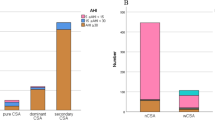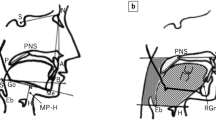Abstract
Objective
Apnea-hypopnea index is the number of apnea-hypopnea events observed during polysomnography within an hour. Mean apnea-hypopnea duration is the mean duration of all apneas and hypopneas. In this study, we aimed to investigate the association of mean apnea-hypopnea duration in patients with obstructive sleep apnea with clinical and polysomnographic parameters.
Methods
In our hospital, a total of 764 patients were diagnosed with OSA by polysomnography in 2017. Age, body mass index, and the current diseases were recorded. Sleep structures obtained from polysomnography readings, blood oxygen levels, apnea-hypopnea index, and mean average duration were recorded. Patients with mean average duration of 20 s or more were assigned to the long average duration group and those with less than 20 s were assigned to the short average duration group. Groups were compared in terms of clinical and polysomnographic parameters.
Results
Snoring, witnessed apnea, morning tiredness, and hypertension were significantly higher in the long average duration group. There was statistically significantly more male patients and higher neck circumference in the MAD group. Total wake duration, percentage of sleep, stage 3, stage 1, and mean oxygen saturation percentage of the long average duration group were significantly reduced.
Conclusion
In present study, the patients with obstructive sleep apnea with long average duration were found to have more negative effects of sleep apnea than the patients with short average duration. We think that the use of mean apnea-hypopnea duration as an indicator with apnea-hypopnea index will be beneficial for the follow-up and treatment of the disease.
Similar content being viewed by others
References
Kapur VK, Auckley DH, Chowdhuri S, Kuhlmann DC, Mehra R, Ramar K, Harrod CG (2017) Clinical practice guideline for diagnostic testing for adult obstructive sleep apnea: an American Academy of Sleep Medicine clinical practice guideline. J Clin Sleep Med 13:479–504. https://doi.org/10.5664/jcsm.6506
Terán-Santos J, Jiménez-Gómez A, Cordero-Guevara J (1999) The association between sleep apnea and the risk of traffic accidents. Cooperative Group Burgos-Santander. N Engl J Med 340(11):847–851
Maeder MT, Schoch OD, Rickli H (2016) A clinical approach to obstructive sleep apnea as a risk factor for cardiovascular disease. Vasc Health Risk Manag 12:85–103
Earl DE, Lakhani SS, LariauxDB SAR (2019) Predictors of moderate to severe obstructive sleep apnea:identification of sex differences. Sleep Breath. https://doi.org/10.1007/11325-019-01790
Berry RB, Budhiraja R, Gottlieb DJ et al (2012) Rules for scoring respiratory events in sleep: update of the 2007 AASM manual for the scoring of sleep and associated events. Deliberations of the sleep apnea DefinitionsTask force of the American Academy of Sleep Medicine. J Clin Sleep Med 8:597–619
Dewan NA, Nieto FJ, Somers VK (2015) Intermittent hypoxemia and OSA implications for comorbidities. Chest. 147(1):266–274
Koo BB, Mansour A (2014) Correlates of obstructive apnea duration. Lung. 192:185–190
Zhan X, Fang F, Wu C, Pinto JM, Wei Y (2018) A retrospective study to compare the use of the mean apnea-hypopnea duration and the apnea-hypopnea index with blood oxygenation and sleep patterns in patients with obstructive sleep apnea diagnosed by polysomnography. Med Sci Monit 24:1887–1893
Darien IL (2014) American Academy of sleep medicine. International classification of sleep disorders. Third ed. Chest 2014 146(5):1387–1397
Kimoff RJ, Cheong TH, Olha AE, Charbonneau M, Levy RD, Cosio MG, Gottfried SB (1994) Mechanisms of apnea termination in obstructive sleep apnea. Role of chemoreceptor and mechanoreceptor stimuli. Am J Respir Crit Care Med 149(3 Pt1):707–714
Gleeson K, Zwillich CW, White DP (1990) The influence of increasing ventilatory effort on arousal from sleep. Am Rev Respir Dis 142:295–300
Liu J, Xiao Y (2014) Approximate entropy of oxygen saturation and saturation impairment time index for the assessment of hypoxemia severity in obstructive sleep apnea hypopnea syndrome. Zhonghua Nei Ke ZaZhi 53(8):607–610
Somers VK, White DP, Amin R, Abraham WT, Costa F, Culebras A et al (2008) Sleep apnea and cardiovascular disease: an American Heart Association/American College of Cardiology Foundation Scientific Statement from the American Heart Association Council for High Blood Pressure Research Professional Education Committee, Council on Clinical Cardiology, Stroke Council, and Council On Cardiovascular Nursing. In collaboration with the National Heart, Lung, and Blood Institute National Center on Sleep Disorders Research (National Institutes of Health). Circulation 118:1080–1111. https://doi.org/10.1161/CIRCULATIONAHA.107.189375
McNicholas WT, Bonsigore MR, Bonsignore MR (2007) Management committee of EU COST ACTION B26. Sleep apnea as an independent risk factor for cardiovascular disease: current evidence, basic mechanisms and research priorities. Eur Respir J 29:156–178
Carscadon M, Dement WC (2000) Normal human sleep: an overview. In: Kryger MH, Roth T, Dement WC (eds) Principles and practice of sleep medicine, 3rd edn. W.B. Saunders Co., Philadelphia, pp 15–25
Wu H, Zhan X, Zhao M, Wei Y (2016) Mean apnea hypopnea duration (but not apnea-hypopnea index) is associated with worse hypertension in patients with obstructive sleep apnea. Medicine (Baltimore) 95(48):e5493
Acknowledgments
The authors thank Dr. Cuneyt Salturk for her kind support of the statistical analyses.
Author information
Authors and Affiliations
Contributions
1- Literature research: (SS, GCA).
2- Data collections (SS, GCA).
3- Study design (SS).
4- Analysis of data: (SS, GCA).
5- Manuscript of preparation (SS).
6- Review of manuscript (all authors).
Corresponding author
Ethics declarations
Conflict of interest
The authors declare that they have no conflict of interests.
Ethical approval
All procedures performed in studies involving human participants were in accordance with the ethical standards. Informed consent was obtained from all individual participants included in the study.
Additional information
Publisher’s note
Springer Nature remains neutral with regard to jurisdictional claims in published maps and institutional affiliations.
Rights and permissions
About this article
Cite this article
Saraç, S., Afsar, G.C. Effect of mean apnea-hypopnea duration in patients with obstructive sleep apnea on clinical and polysomnography parameter. Sleep Breath 24, 77–81 (2020). https://doi.org/10.1007/s11325-019-01870-y
Received:
Revised:
Accepted:
Published:
Issue Date:
DOI: https://doi.org/10.1007/s11325-019-01870-y




